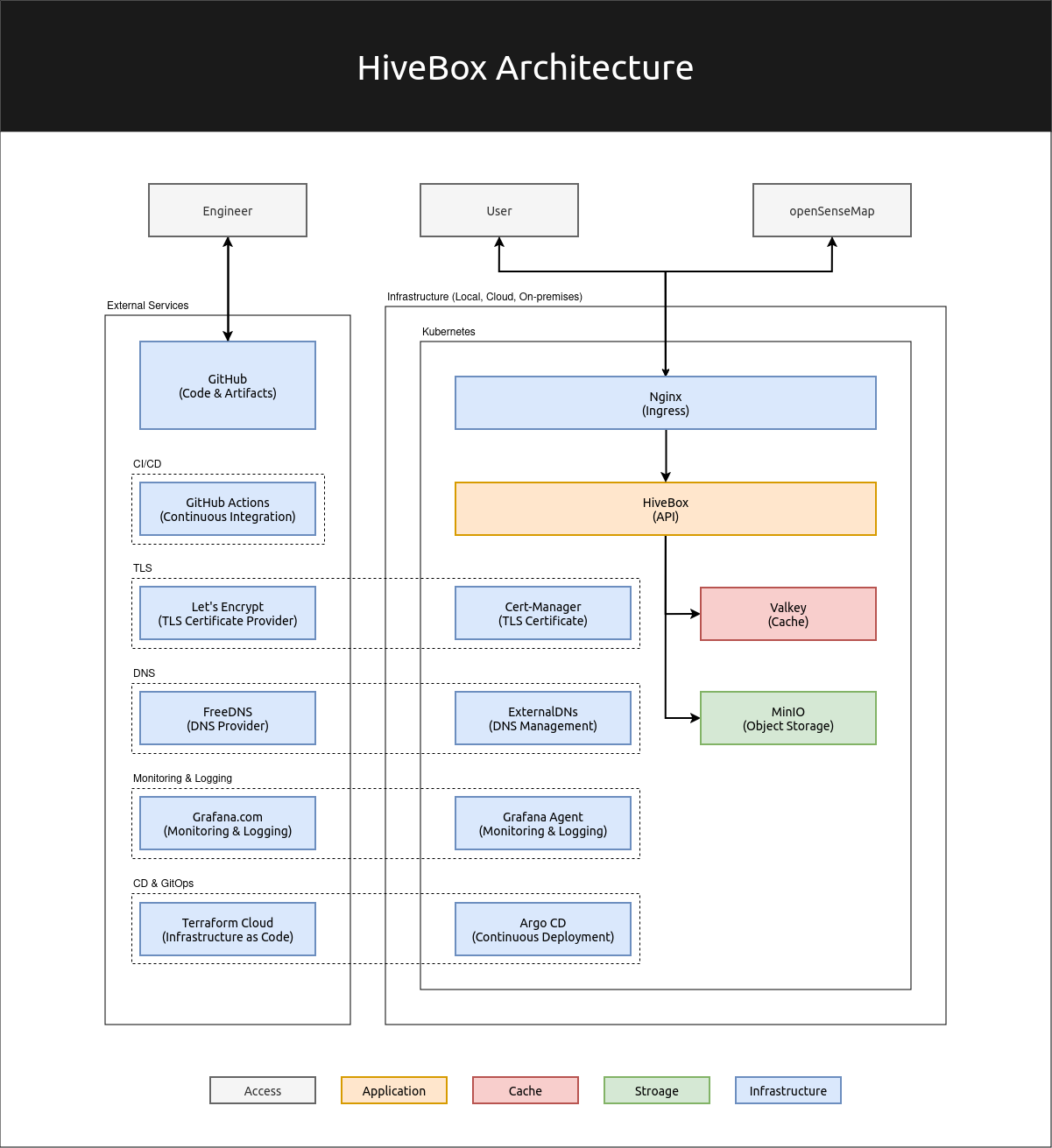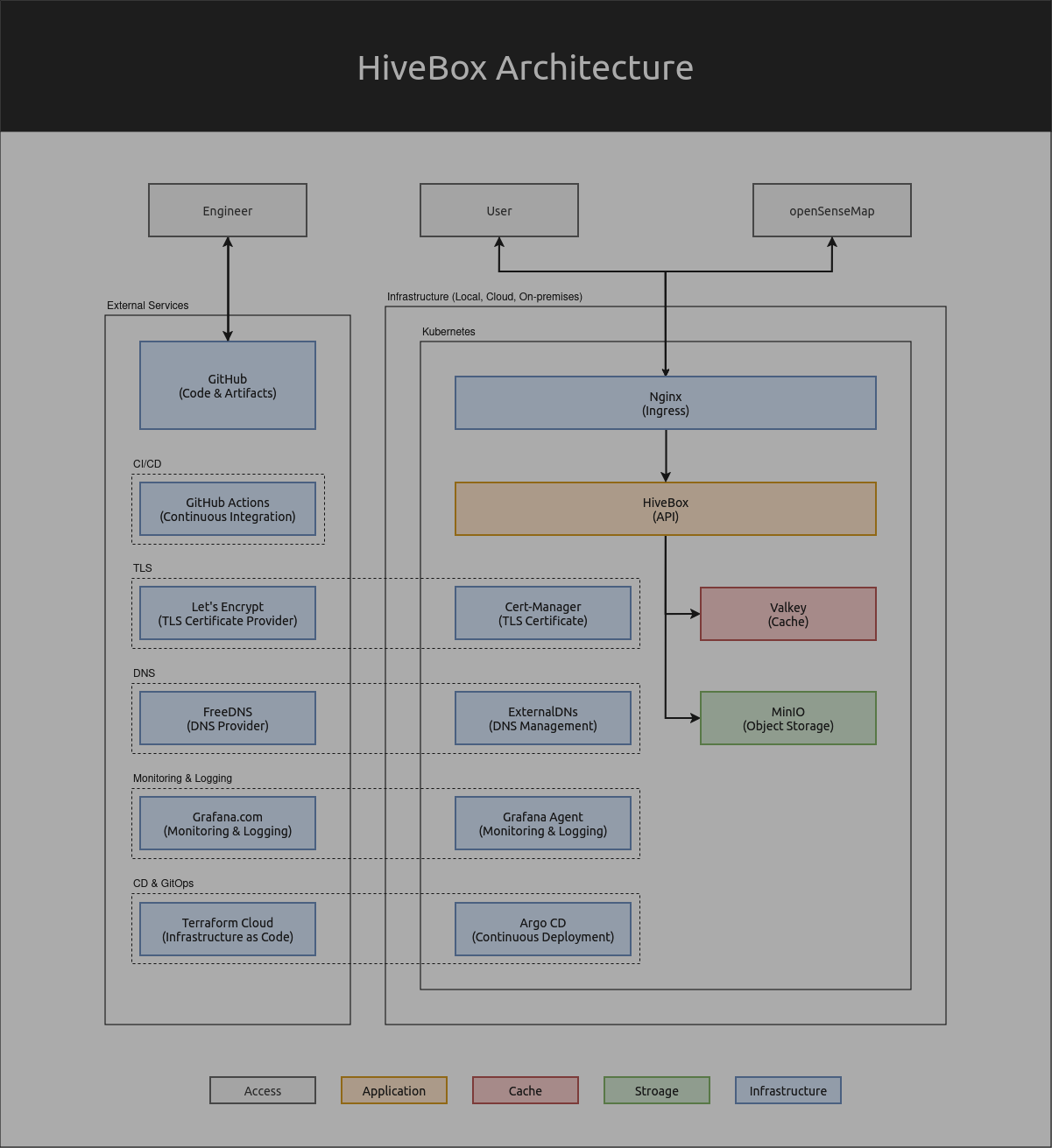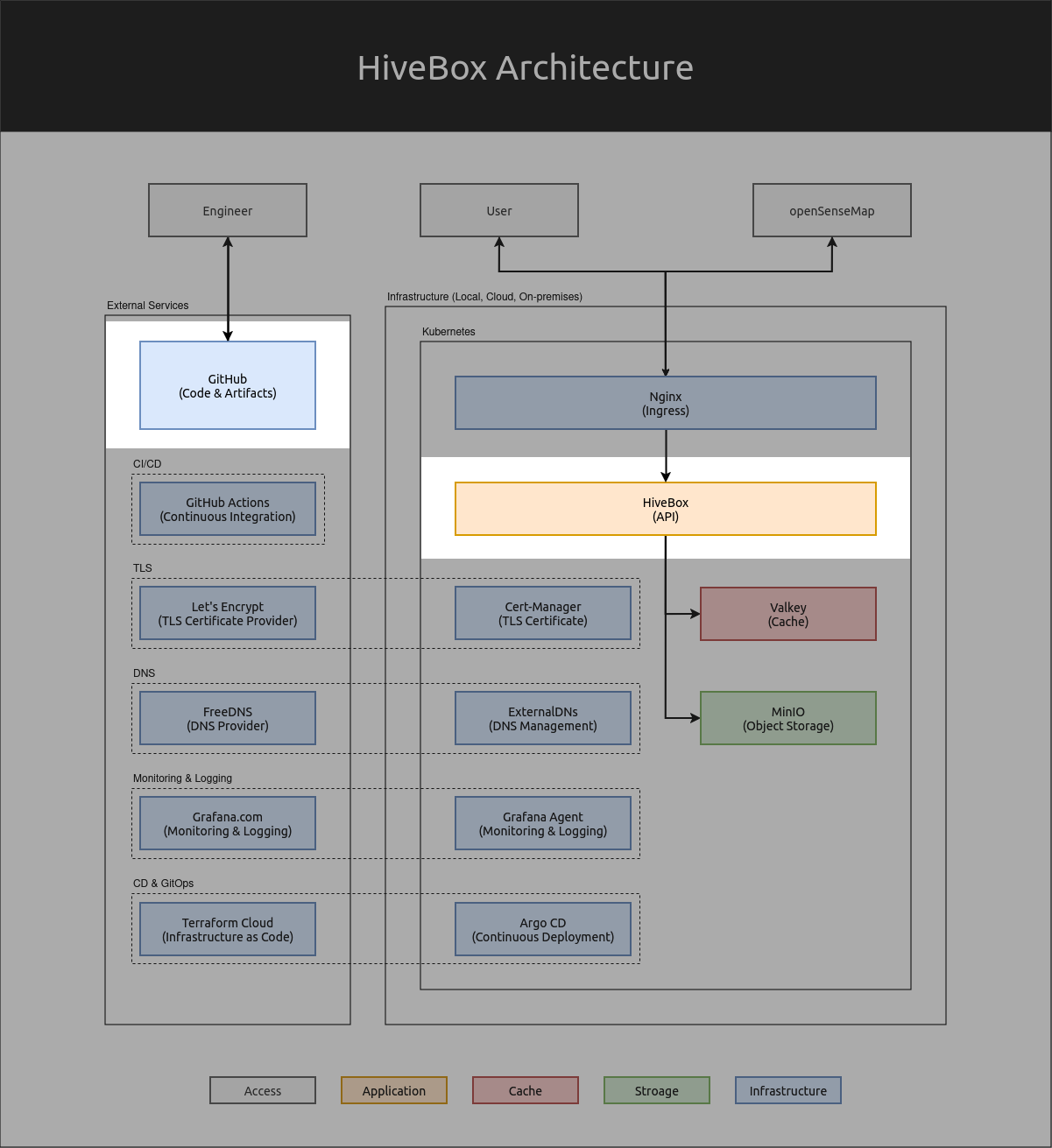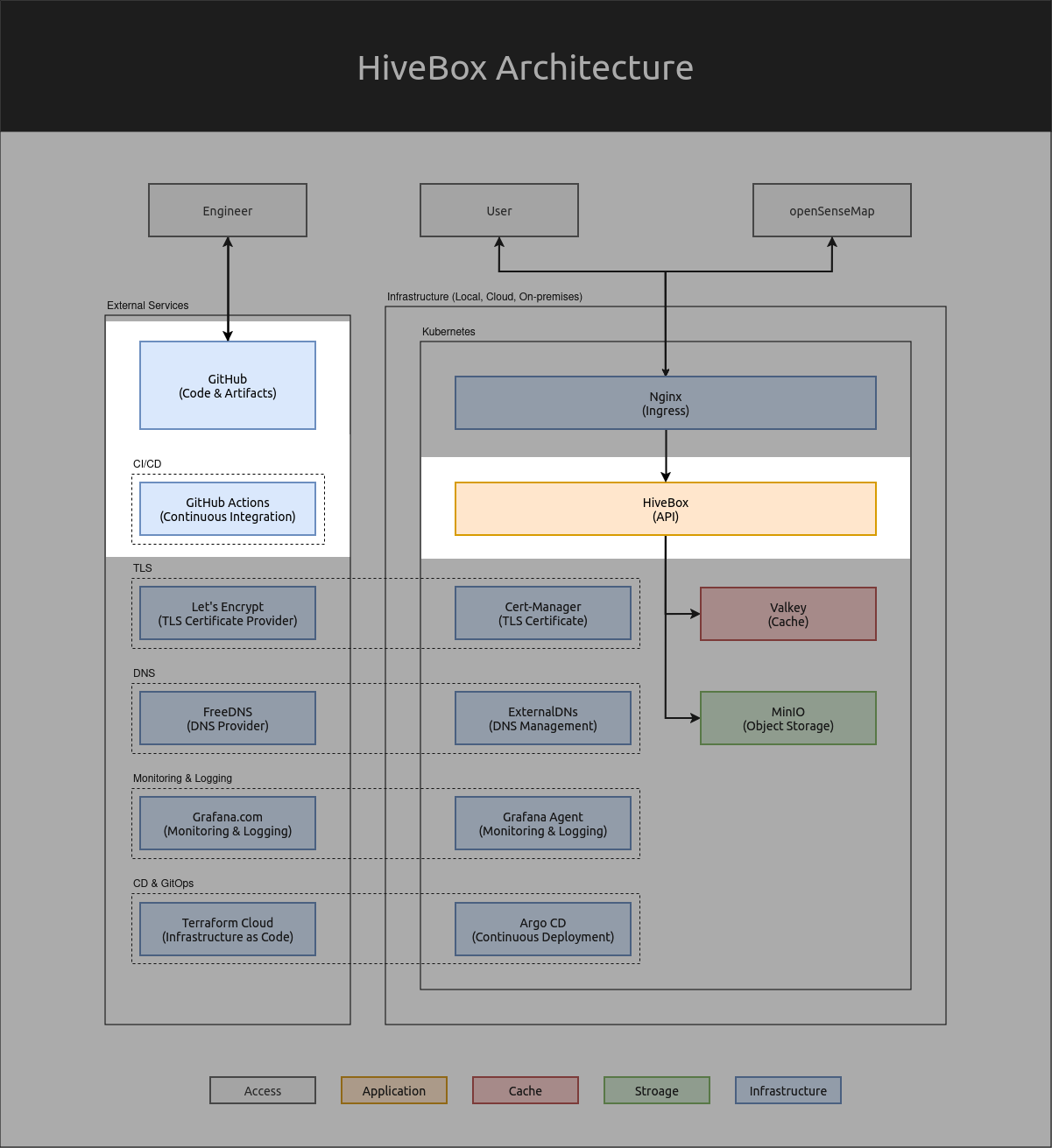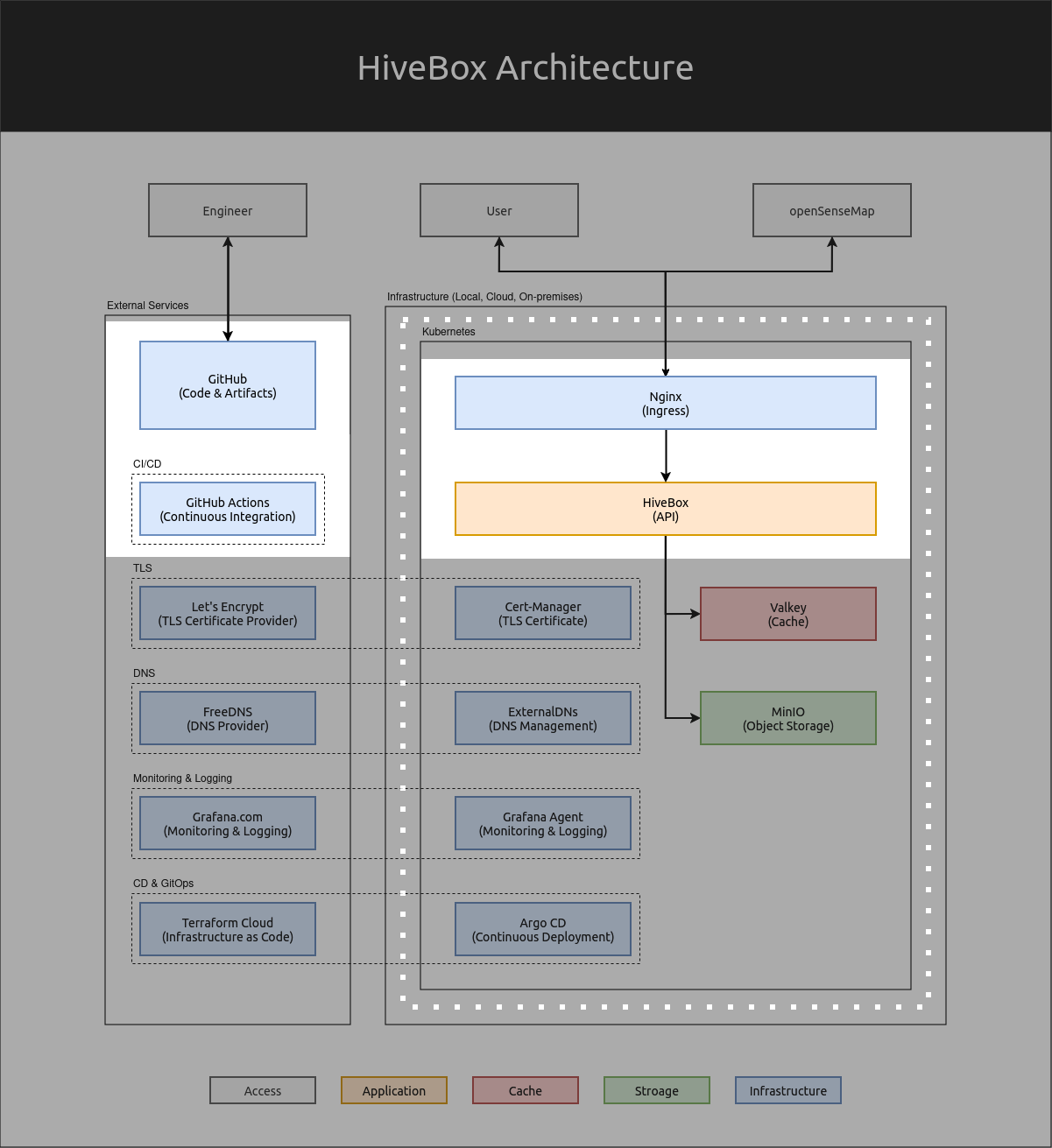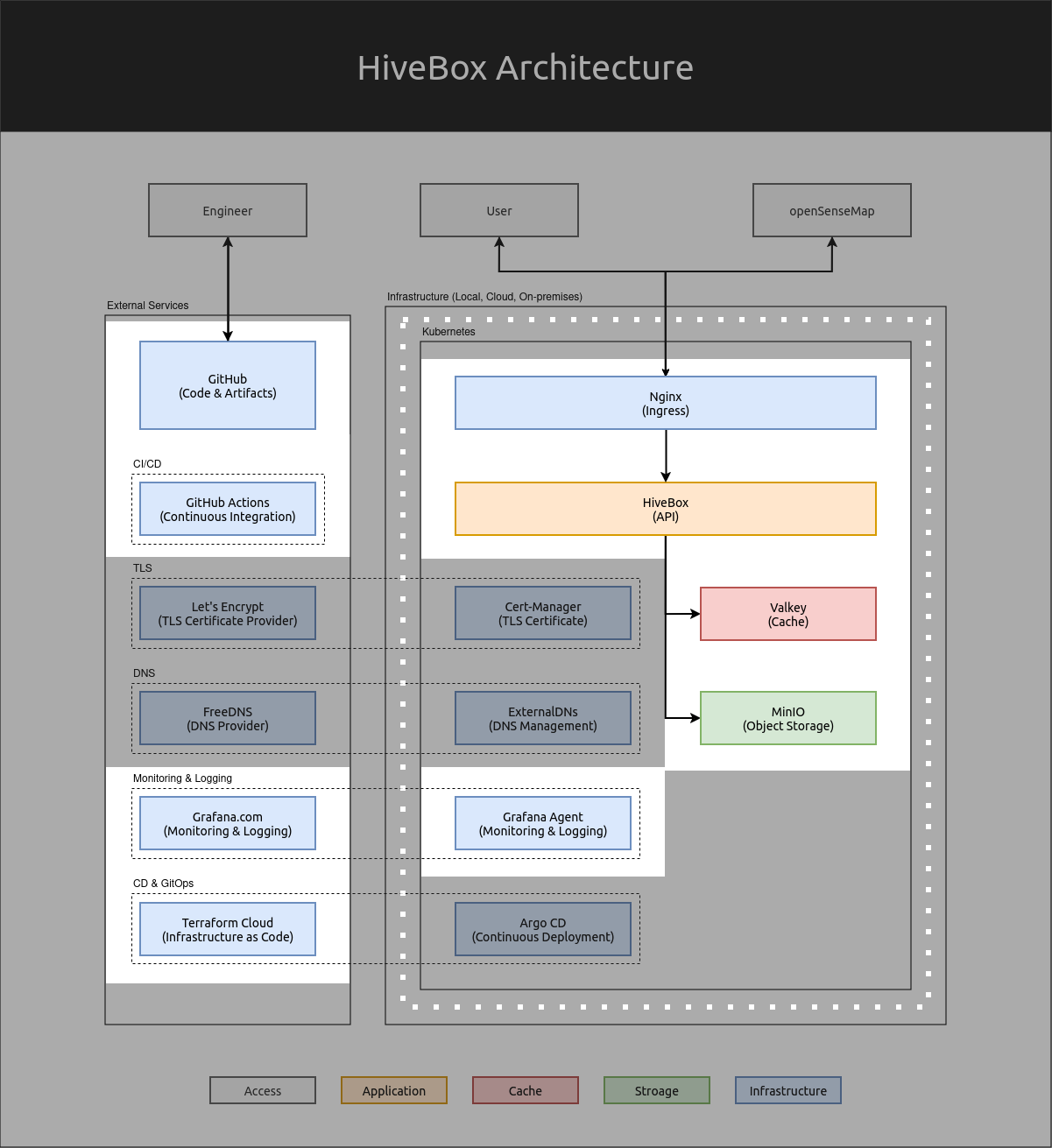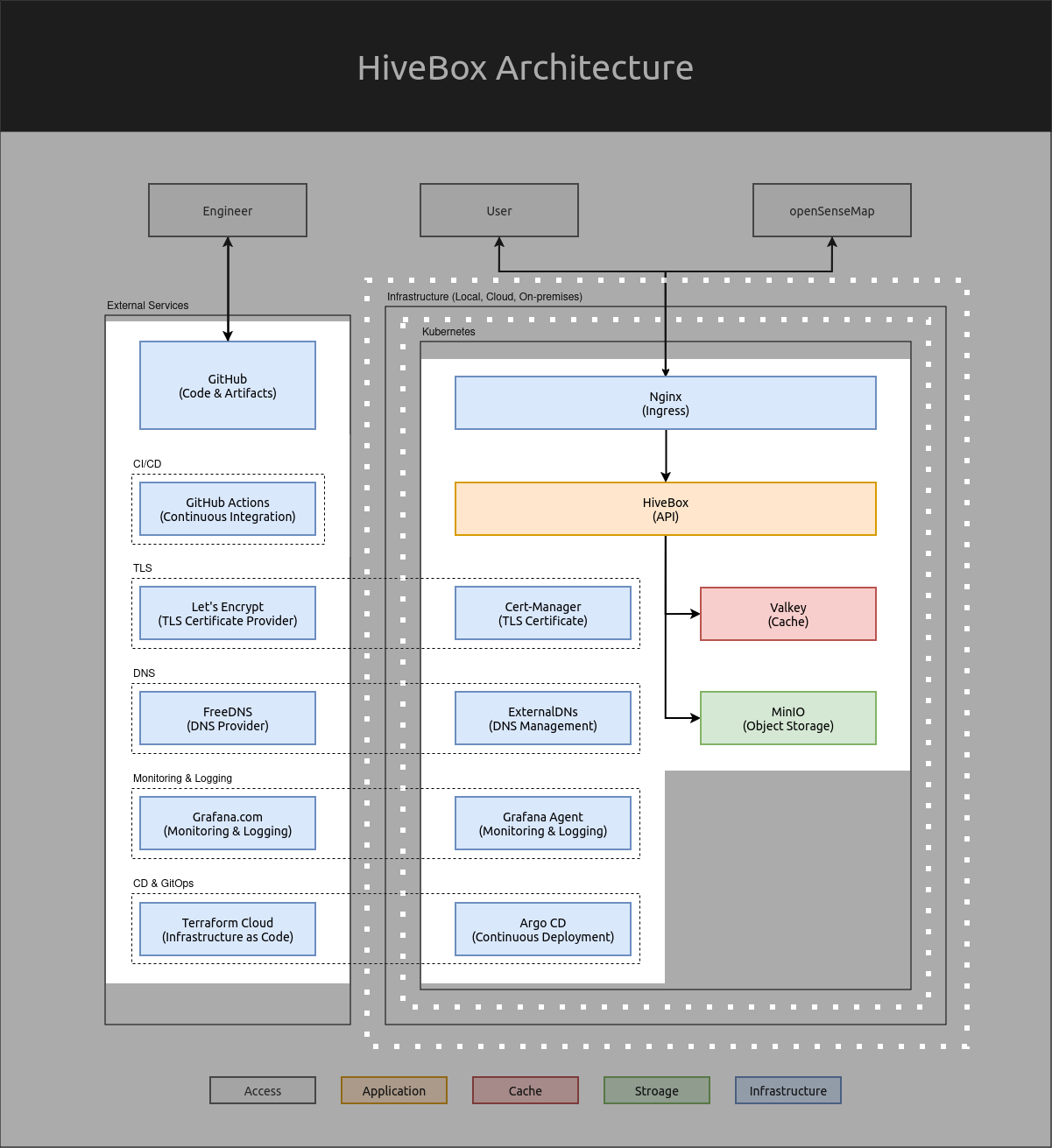End-to-End Project: HiveBox
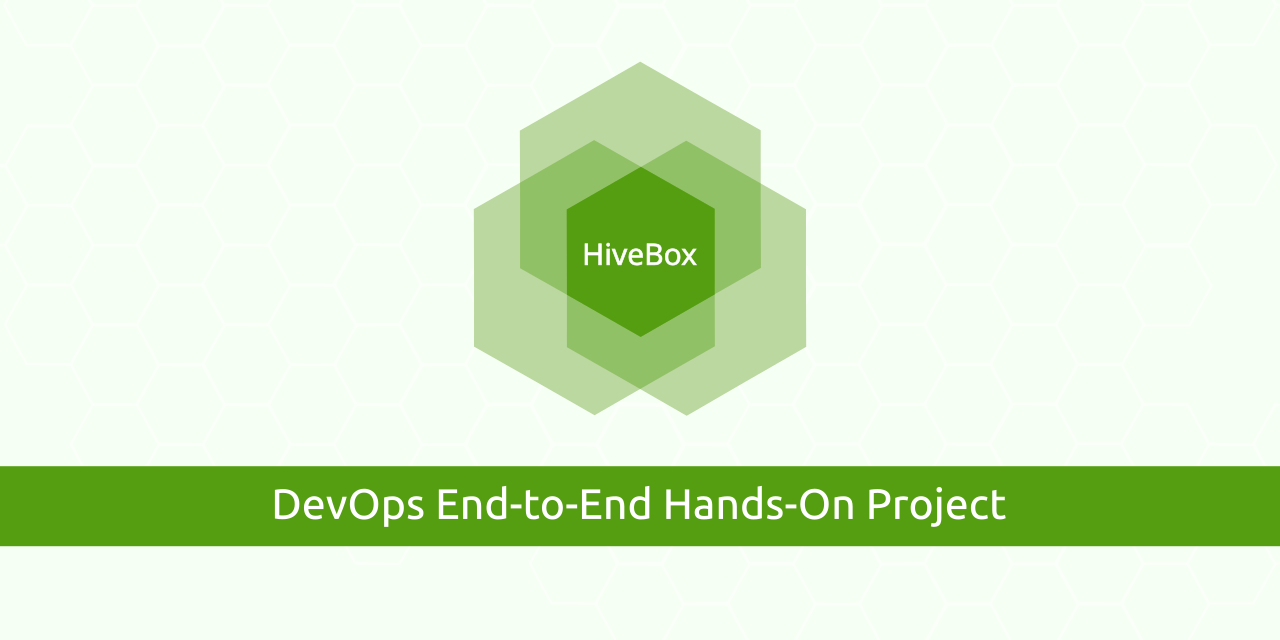
Almost everyone loves honey, and we at DevOps Hive love it too and appreciate bees' role for the planet! Because bees are essential to people and the planet. For that reason, our main hands-on project will be for the bees in this roadmap!
In this DevOps end-to-end hands-on project, we will utilize the technology and open-source software to build an API to track the environmental sensor data from openSenseMap, a platform for open sensor data in which everyone can participate.
In this project, you will cover many topics:
- Software Production.
- Agile Planning.
- QA and Quality Gates.
- Code and Programming.
- Operating System.
- Docker Containers.
- Kubernetes and Cloud.
- Observability and Monitoring.
- Continuous Integration/Delivery/Deployment.
- Automation and Infrastructure as Code.
If you are looking for the full roadmap, including this project, go back to the getting started page.
Approach

This project follows the same Dynamic MVP-style mindset used in the roadmap, which aims to cover the whole Software Development Life Cycle (SDLC). That means each phase of this project will cover all aspects of the DevOps areas like planning, coding, containers, testing, continuous integration, continuous delivery, infrastructure, etc.
This project works best in Pairing mode, where you have another person to help you whenever you get stuck (like a mentor or something). But in case you don't have that, always back to the Related Module where it has more details could help you in the project.
Tips
- Avoid stereotypes about yourself! You have to think differently this time!
- Say
NOmore to other things during the project implementation. Even good things, i.e., stay focused! - Remember, life is all about trade-offs! You can do anything if you stop trying to do everything.
Each phase of this project is tackled gradually as part of the roadmap modules. But it's also standalone, and you can work on it if you have the required knowledge for each phase.
Remember, the goal is to implement the project and learn industry best practices in the DevOps field! Just applying this project without understanding the problems to solve will not help you become a DevOps Engineer!
Goal
This project aims to build a real system from code to infrastructure and everything in between in iterative phases
⭐ Click on the diagram to see it animated ⭐
The goal of this project is to build a scalable RESTful API around openSenseMap but customized to help beekeepers with their chores. The API output should be in JSON. You will start with a basic implementation and then extend the whole system to handle thousands of requests per second. But always remember, every decision has a cost.
Happy DevOpsing ♾️
Phase 1
Roadmap Module: Welcome to the DevOps World
1.1 Kickoff
- Understand your role in this project and how you work with other teams (assume you are in a team and don't act like you are working alone!)
- Brush up on your knowledge about Software Project management (Hint: What is agile project management?).
- Decide which Agile methodology you will use, such as Scrum, Kanban, or Scrumban (Kanban is recommended for this project).
- Avoid Scope Creep! Make it work, make it right, make it fast!
- Don't forget! You are managers of one!
1.2 Preparation
- Create GitHub account (if you don't have one), then fork HiveBox repository on GitHub and start from there.
- Create GitHub project board for this repository (use
Kanbantemplate). - Each phase should be presented as a pull request against the
mainbranch. Don’t push directly to the main branch! - Document as you go. Always assume that someone else will read your project at any phase.
- You can get senseBox IDs by checking the openSenseMap website. Use 3 senseBox IDs close to each other (you can use the following 5eba5fbad46fb8001b799786, 5c21ff8f919bf8001adf2488, and 5ade1acf223bd80019a1011c). Just copy the IDs, you will need them in the next steps.
Phase 2
Roadmap Module: Basics - DevOps Core
2.1 Tools
- Git
- VS Code
- Docker
2.2 Code
- Implement the code requirements in your GitHub repository fork for the project (done in phase 1).
Requirements:
- As an initial version of the HiveBox app, use the Semantic Versioning
v0.0.1. - Create a function that prints the current app version. It just needs to print the version and then exit.
2.3 Containers
- Create a
Dockerfilefor the project. - Build the Docker image and run it locally.
2.4 Testing
- Locally, run the app container and ensure it returns the correct value.
- Ensure that documentation is provided on how to test the application.
Phase 3
Roadmap Module: Start - Laying the Base
3.1 Tools
3.2 Code
- Use Conventional Commits for Git commits.
- Familiarize yourself with openSenseMap API.
- Implement the code requirements (Hint: Flask Quickstart or FastAPI) .
- Write unit tests for all endpoints.
Requirements:
Version:
- Endpoint:
/version - Parameters: No parameters.
- Requirements:
- Returns the version of the deployed app.
Temperature:
- Endpoint:
/temperature - Parameters: No parameters.
- Requirements:
- Return current average temperature based on all senseBox data.
- Ensure that the data is no older than 1 hour.
3.3 Containers
- Apply Best Practices for containers (Hint: Docker Best Practices).
3.4 Continuous Integration
- Create a GitHub Actions workflow for CI.
- Add a step to lint code and Dockerfile.
- Add a step to build the Docker image.
- Add step to unit tests.
- Setup OpenSSF Scorecard GitHub Action and fix any issues reported by it.
3.5 Testing
- In the CI pipeline, call the
/versionendpoint and ensure it returns the correct value.
Phase 4
Roadmap Module: Expand - Constructing a Shell
4.1 Tools
- Kind
- Kubectl
4.2 Code
- Implement the code requirements.
- Write integration test (Hint: 3 ways to test your API with Python).
Requirements:
General:
- The senseBox should be configurable via env vars.
Metrics:
- Endpoint:
/metrics - Parameters: No parameters.
- Requirements:
- Returns default Prometheus metrics about the app.
Temperature:
- Endpoint:
/temperature - Parameters: No parameters.
- Requirements:
- Add a "status" field based on the temperature average value.
- Less than 10: Too Cold
- Between 11-36: Good
- More than 37: Too Hot
- Add a "status" field based on the temperature average value.
4.3 Containers
- Create a KIND configuration to run with Ingress-Nginx.
- Create Kubernetes core manifests to deploy the application.
4.4 Continuous Integration
- Run code integration tests.
- Run SonarQube for code quality, security, and static analysis (Hint: Use SonarQube Quality Gate check action, also consider Semgrep).
- Run Terrascan for Kubernetes manifest misconfigurations and vulnerabilities (Hint: Terrascan GitHub Action).
- Apply Best Practices for CI (Hint: Best practices when adopting continuous integration).
4.5 Continuous Delivery
- Create a GitHub Actions workflow for CD.
- Add step to release by pushing a versioned Docker image to a container registry (Hint: Use GitHub Container registry).
Phase 5
Roadmap Module: Transform - Finishing the Structure
5.1 Tools
- Kind
- Kubectl
5.2 Code
- Implement the code requirements.
Requirements:
General:
- Add a caching layer using a Redis-Compatible project Valkey.
- Add a storage layer using S3-Compatible project MinIO and store the data periodically every 5 minutes.
Store:
- Endpoint:
/store - Parameters: No parameters.
- Requirements:
- By default, the application will store the data every 5 minutes, but by calling this endpoint, it should store it directly on MinIO.
Metrics:
- Endpoint:
/metrics - Parameters: No parameters.
- Requirements:
- Extend the Prometheus metrics by adding custom metrics based on the code logic.
Readyz:
- Endpoint:
/readyz - Parameters: No parameters.
- Requirements:
- Returns HTTP 200 unless:
- 50% + 1 of the configured senseBoxes are not accessible.
- AND caching content is older than 5 minutes.
- Returns HTTP 200 unless:
5.3 Containers
- Create a Helm chart for the application (Hint: Awesome Helm List).
- Create Kustomize manifests for the infrastructure resources like KeyVal (Hint: Awesome Kustomize List).
- Review Kubernetes Security Best Practices (Hint: Kubernetes Security Best Practices with tips for the CKS exam).
- Configure the Kubernetes app manifest to use
/readyzas a readiness probe.
5.4 Infrastructure as Code
- Deploy Grafana agent to collect logs and metrics (Hint: Create Grafana Cloud free account to Use Loki and Grafana).
- Create a Kubernetes cluster using Terraform IaC (Hint: Use free tier from any Cloud provider).
5.5 Continuous Integration
- Create End-to-End test (Hint: Venom, a declarative test suite).
- Run the KIND cluster, deploy the app and infrastructure, then run the End-to-End test.
5.6 Continuous Delivery
- Apply Best Practices for CD.
Phase 6
Roadmap Module: Optimize - Keep Improving
This phase a free-style user-defined enhancements which means the enhancements could be related to any part of the project.
Here are some highly recommended suggestions:
- Deploy the application in Declarative GitOps style using Argo CD.
- Prepare for production by setup DNS (ExternalDNS) and Certificates (Cert-Manager).
- Automate dependency updates with Dependabot.
- Move all external services (Like Grafana.com and Terraform Cloud) to the Kubernetes cluster using open-source solutions.
Here are some extra suggestions:
- Setup Kyverno for Policy as Code.
- Build Multi-environment Kubernetes clusters (Dev, Stage, and Prod) with Terraform and Kustomize.
- Use TestKube for better testing execution.
- Develop a Kubernetes Operator to handle the app operations (Hint: Introduction to Kubernetes Operators).
Phase 7
Roadmap Module: Capstone Project
In this phase, you will design and implement your own project similar to the HiveBox project but with an idea and a tech stack of your choice. Check the Capstone Project page for more details.
